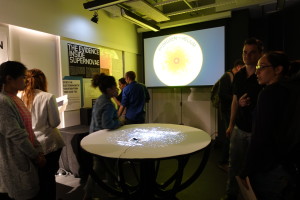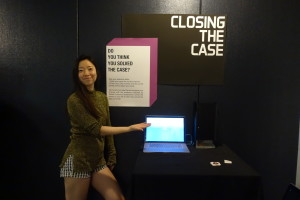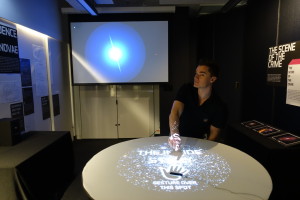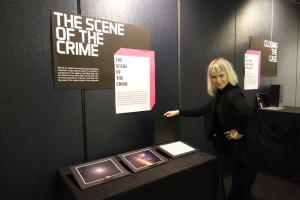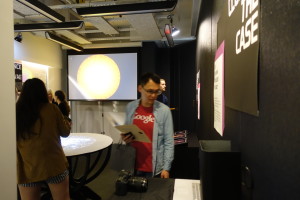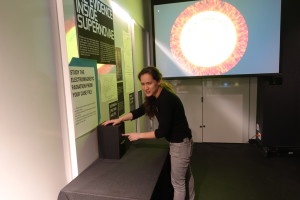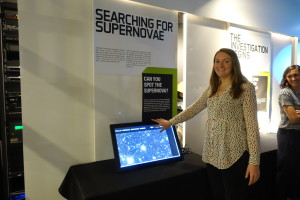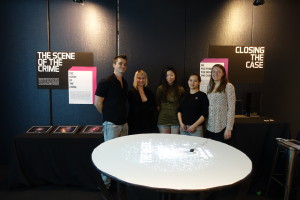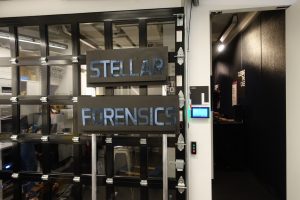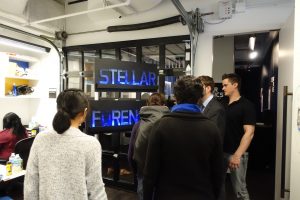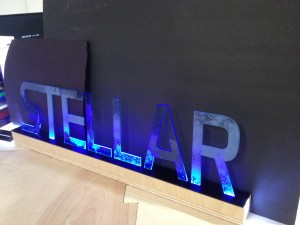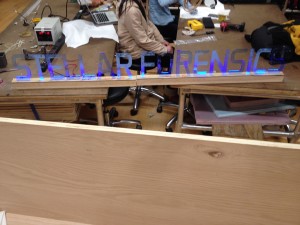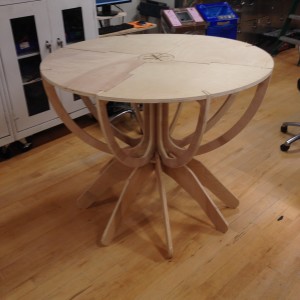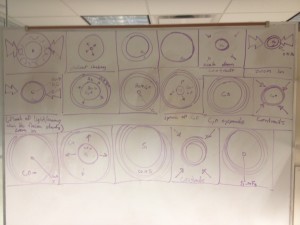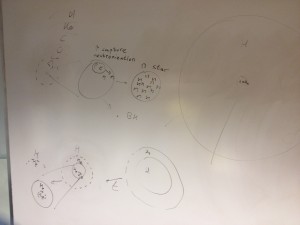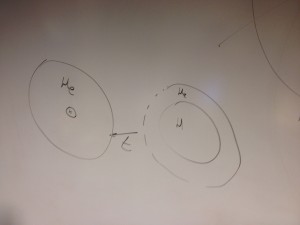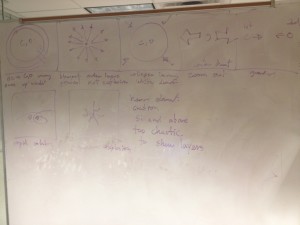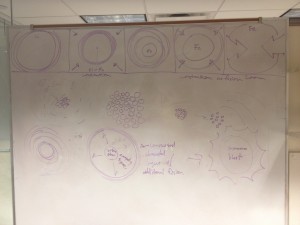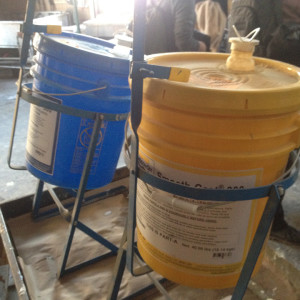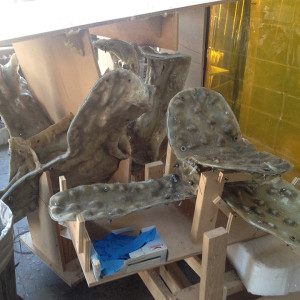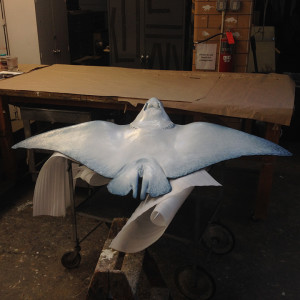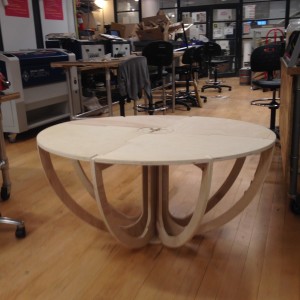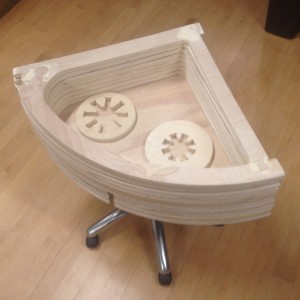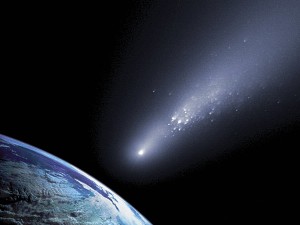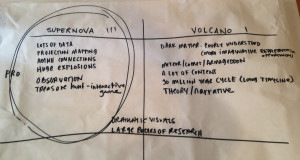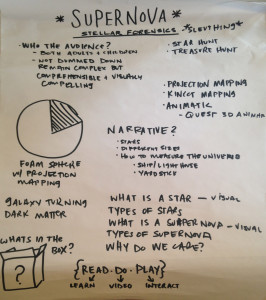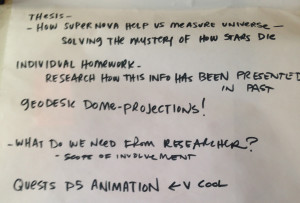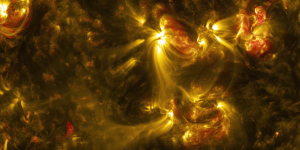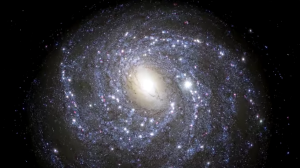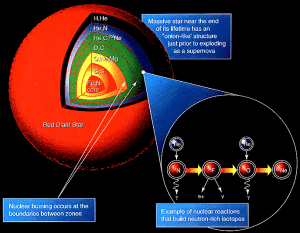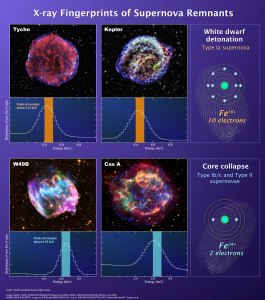Playful Communications of Serious Research
Instructor: Lillian Preston
Pop Up Exhibit:
Stellar Forensics
The exhibit guides visitors through a detective game which reveals the true nature of a suspected supernova observation.
Week 8:
Updates
Lettering:
Projection Table:
Met with our researcher and did extensive storyboarding for the supernova core animations:
With this vital information I am hoping to create an animated display that is engaging, scientifically correct (ballpark), and informative.
Week 7:
The excursion to the American Museum of Natural History was an eye-opener. The part of the tour that really got me excited was the sculpture studio with it’s mold making materials. I was also jazzed by the woodworking and metalworking areas.
This image might not mean much to most people, but I knew at first glance that these are Smooth-on mold making products. The yellow and blue are two parts of a formula that once mixed together produces a flexible mold. Thus an original sculpt in oil clay can be turned into a copy in a more robust material (resin, plaster, plastic, rubber, etc) that can withstand the rigors of a permanent exhibit.
Here we see a large scale, multi-part mold with a fiberglass mother mold and wooden support structure.
This stingray model is almost finished, it has been sculpted, molded, and painted. I would LOVE to work on models like this with the tools and space available at the AMNH.
Week 6:
Signage Template for acrylic cut and etch.
Projection table fabrication is proceeding well.
This is the table assembled (still deciding on height for legs).
The projection table is assembled from 14 smaller pieces in approximately three minutes with no tools or adhesives. Ideal for quick setup and breakdown.
Week 5:
Message, audience, environment, approach.
A full end to end description on user experience is what is needed. Linear experience versus choose your own experience. How do you signal to people that they should move on to the next part of the exhibit. From big picture to more focussed look. This is the superficial experience versus this is the in depth experience.
Design package next.
Which parts can be interactive and why?
Week 4:
Meeting with group to refine Concept Package
Week 3:
Guest speaker: Matthew McNerny
Design Direction @ Potion Design Studios
Concept is important; it roots the project for you and the client. It makes the design decisions easier to make.
Go outside the ballpark for inspiration. If the medium reflects the message it will be received better. Some content is dates itself. Break up the experience so that monotony does not take over. Put creative vision first. Tech should allow for accessibility of information and not be the focus of the project. Make the visitor feel like a magician.
“This is the story that I want to tell.”
Designing for content versus solving a problem directive. Fresh eyes as a valuable resource.
Demographics, thinking about your audience and how they will experience the exhibit.
Streakers, scanners, studiers, and selfie-er. Imagine different audience types, build them out.
Spatial planning with regards to the exhibition space. How many layers?
Week 2:
Concept Package: a roadmap for the project; what is the intent and how will it be accomplished.
A one page description (almost like a grant proposal).
As of today I have had meetings with researchers in the following areas:
US National Security Whistleblowers
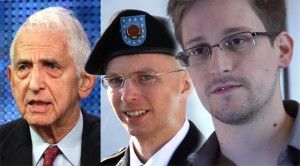
– Prof Hannah Gurman
Hannah is currently in the planning phases for this area of research. As of yet there is interest but not much in the way of thesis. The subject matter is very intriguing; especially given that there is a sharp disparity between the fates of whistle blowers from the 20th century versus their contemporaries. There is also the depressing spectre of futility given that US foreign policy has changed very little in response to public revelations about wrongdoing on the part of the government and government officials.
Supernovae and Stellar Forensics
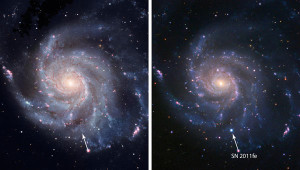
– Or Graur
When stars use up their hydrogen fuel they explode in spectacular bursts of light and radiation Effects of Earth’s Motion in Space on
30 Million Year Galactic Cycle of Impactors, Volcanism, and Mass Extinctions
– Prof Rampino
As our solar system revolves around the center of the Milky Way galaxy we also bob up and down through the central galactic disk. This region causes gravitational effects that send comets from the Oort Cloud towards the inner solar system causing extinction level impacts. At the same time, clumps of dark matter are absorbed by the earth, causing particle – antiparticle annihilation in the planet’s core; ramping up volcanic activity on a global scale. This theory has been around since the 80’s but has received new attention recently thanks to advances in astrophysics.
Group Meeting Sunday February 7th.
Supernova and Stellar Forensics was chosen for the subject of our exhibit.
Decision making documentation
Initial ideas and questions:
Tasks moving forward:
The American Museum of Natural History: “Dark Universe” and Nasa: “Thermonuclear Art”
Supernovae / Stellar Forensics won out in my mind for several reasons. Out of all the subjects we followed up on, it offers up the most comprehensive, developed research within a single discipline. A body of research that is diagram and data rich but lacking in polished media. During our meeting with Or we asked for a wish list of animations and illustrations from his research team and he was sure that there would be very strong interest. I am currently finding a wealth of inspiration from animations and supercomputer simulations created by NASA. The time lapse video they created recently of the Sun (the nearest star) is spectacular. Convection currents, roiling magnetic disturbances, and flares are an excellent starting point in simulating other stellar phenomena.
I am going to explore the Dark Universe exhibit at the Natural Science Museum this week. The trailer for the show has several point of inspiration, especially the galactic timelapse animation showing supernovae as points of blinking light.
As far as ideas for the mechanics heavy element creation during stellar death, I think that these onion like fusion layers lend themselves to a circular projection table showing how the layers develop and grow in different types of supernova explosions.
To engage younger viewers our group is discussing the narrative of a detective story (where is Waldo the supernova) that could be turned into a game. Also the images of supernova remnants (part of the forensic analysis) offers another source of visual inspiration.
Week 1:
Introductions and class overview.
Examples of exhibition design.
Flow of information. Media landscapes. Content drives decisions.

